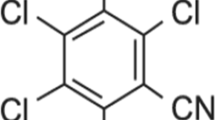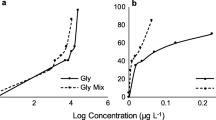Abstract
Fenoxaprop-p-ethyl, a herbicide that is commonly used in Çukurova region, was studied for possible adverse impacts on the Seyhan dam plankton and water quality variables in laboratory microcosms for 40 days. Water containing natural plankton, and sediment were collected from the Seyhan dam. The herbicide was added to six microcosms in 0.1, 1, and 10 mg L−1 concentrations. Two microcosms were used as reference groups. The results indicate that pennat diatom, Cladocera, and Copepoda at 10 mg L−1 contaminations and centric diatom and Chlorophyta at 1 mg L−1 contamination were affected. This herbicide did not alter water quality.


Similar content being viewed by others
References
APHA (1995) Standard methods for the examination of water and wastewater, 19th edn. American Public Health Association, Washington DC
Cuppen JGM, Van den Brink PJ, Van der Woude H, Zwaardemaker N, Brock TCM (1997) Sensitivity of macrophyte-dominated freshwater microcosms to chronic levels of the herbicide Linuron II. Community metabolism and invertebrates. Ecotox Environ Safe 38:25–35
Çevik F, Derici OB, Koyuncu N, Tuğyan C (2007) Water quality and its relation with chlorophyll-a in dry season, in a reservoir of Mediterranean region. Asian J Chem 19(4):2928–2934
Perschbacher PW, Stone N, Ludwig GM, Guy Jr CB (1997) Evaluation of effects of common aerially-applied soybean herbicides and Propanil on the plankton communities of aquaculture ponds. Aquaculture 157:117–122
Perschbacher PW, Ludwig GM (2004) Effects of Diuron and other aerially applied cotton herbicides and defoliants on the plankton communities of aquaculture ponds. Aquaculture 233:197–203
Song LHR, Zhao Y (2005) Biodegradation of Fenoxaprop-p-ethyl by bacteria isolated from sludge. J Hazard Mater B118:247–251
Traas TP, Janse JH, Aldenberg T, Brock TCM (1998) A food web model for fate and direct and indirect effects of Dursban 4E (active ingredient Chlorpyrifos) in freshwater microcosms. Aquat Ecol 32:179–190
Van den Brink PJ, Hartgers EM, Fettweis U, Crum SJH, Van Donk E, Brock TCM (1997) Sensitivity of macrophyte-dominated freshwater microcosms to chronic levels of the herbicide Linuron. I. Primary producers. Ecotox Environ Safe 38:13–24
Acknowledgment
This work was supported (FBE2002 YL348) by the research fund of Çukurova University, Turkey.
Author information
Authors and Affiliations
Corresponding author
Rights and permissions
About this article
Cite this article
Çevik, F., Tutar, M. Effect of Fenoxaprop-p-ethyl on Natural Plankton of the Seyhan Dam: A Microcosm Study. Bull Environ Contam Toxicol 80, 247–250 (2008). https://doi.org/10.1007/s00128-007-9354-9
Received:
Accepted:
Published:
Issue Date:
DOI: https://doi.org/10.1007/s00128-007-9354-9




